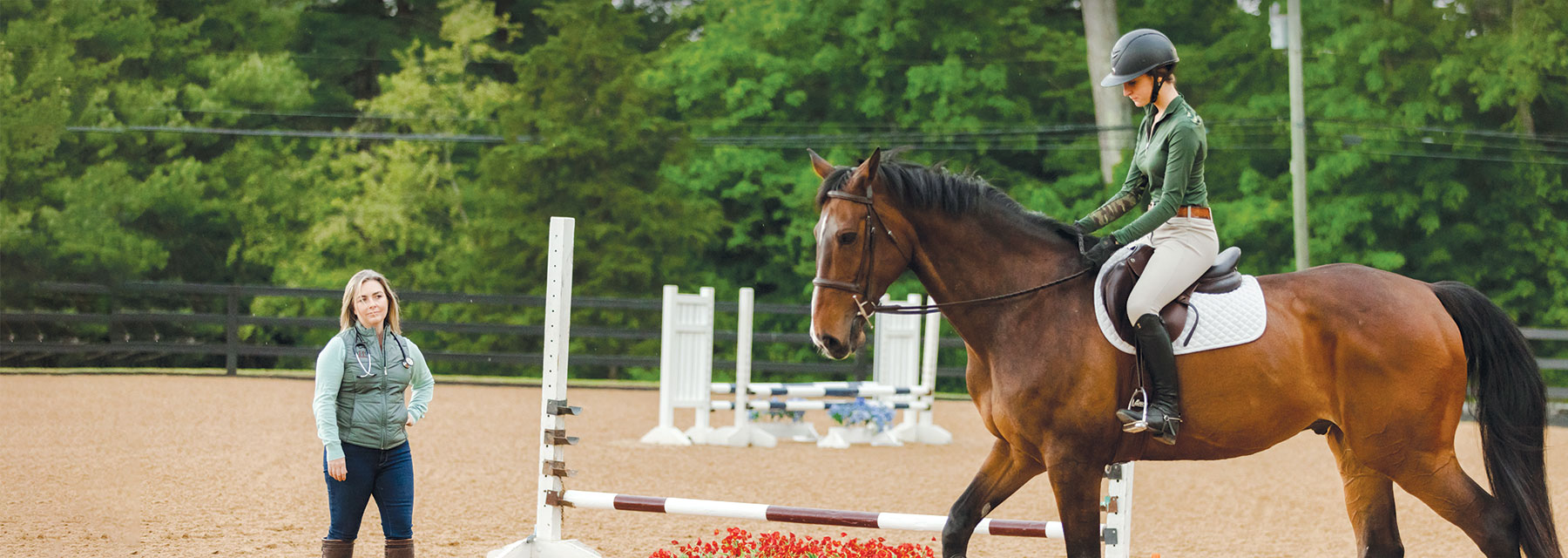Core Fitness and How to Properly Build and Maintain Your Horse’s Vital Center for Optimal Strength, Stability and Performance
The “core.” It’s an oft-used term steeped in misconception. What is the equine core, and how do horse owners fully appreciate and capitalize on its immense role in our horses’ performance? Melissa King, DVM, PhD, DACVSMR is a highly-regarded equine veterinarian practicing at the revered Colorado State University College of Veterinary Medicine and Biomedical Sciences. She’s spent the majority of her celebrated career gaining and sharing a deep understanding of the intricacies surrounding equine musculoskeletal structure and function. Dr. King, board-certified in sports medicine and rehabilitation, is a worldwide authority in her field that has tremendous crossover with human medicine and sport. “If you look to a global definition — whether it’s equine or human, and regardless of the breed or discipline — the core provides the platform from which to execute voluntary movements of the axial (head, neck, back and chest) and appendicular (shoulders, pelvis and limbs) skeleton,” she explains. While the core certainly includes abdominal musculature (the rectus abdominus, transverse abdominus and internal and external obliques), the widespread misconception is the buck stops here, so to speak. “The equine core includes the entire axial skeleton and goes far beyond just the abdominals,” says Dr. King. “In reality the core includes the neck and continues throughout the lumbar spine, pelvis, deep axial muscles (such as the multifidus, hypaxial muscles and sub lumbar muscles) and cervical thoracic musculature, in addition to abdominal musculature.” While the core may be a collection of muscles that play a vital role in performance, its impact reaches far beyond propulsion and power to directly influence a horse’s stability and proper organ function as well.
Human literature has definitively established a link between a weak core in athletes and a higher propensity for injury. A strong and properly conditioned core doesn’t just play a role in performance — it can help prevent an injury from occurring in human or equine athletes. In fact, published human research has shown there is a greater than 25% increase in the likelihood that an athlete with poor core strength and stability will sustain a significant injury prior to starting their season.
Moreover, core musculature also plays a role in minimizing the risk of reinjury after rehabilitation. “As an example, say you sustained a tendon or joint injury that you’ve since rehabilitated, and it’s healed to a satisfactory point; the functional aspect of that injury has come back 100%. As part of the rehab process, if you don’t also work to establish a stronger core, your rate of reinjury coming back from rehab is much higher,” explains Dr. King.
Understanding Core Musculature
With widespread research in human publications, there’s much to be gleaned and further studied in the horse. A particularly important muscle with a thorough understanding in human medicine is the multifidus that spans the whole length of the vertebral column but is most developed in the lumbar area. In translating that work into equine medicine, it’s come a long way and continues to evolve. “It’s an epaxial muscle, meaning that its location is above the transverse processes along the entire axial skeleton from the neck to the lumbar region,” details Dr. King. “It has superficial and deep branches in addition to fascicles that run anywhere from one to five vertebral segments caudally. For example, at T1 it will send a fascicle from T1 to T2, from T1 to T3, from T1 to T4, etc. That happens at each vertebral segment. You can imagine the role that the multifidus has in finite intersegmental stability all along the region of the spine,” she adds. “This muscle is the primary stabilizer of your vertebral column. That tremendous stabilizing effect then allows the bigger, more dynamic and superficial power muscles to move and do their job. Those larger dynamic movement muscles are not your preparatory muscles; they’re not made to stabilize. When the multifidus is weaker than those larger, dynamic muscles, they then become responsible for taking up the role of stabilization. They’re just not made to do that, and that’s when you subject yourself to injury.” When we boil it down, a strong and well-conditioned equine multifidus is like a strong foundation on which a structure can be built. Without it, a horse’s ability to power and propel in sport is greatly compromised.
When zeroing in on the multifidus specifically, research suggests that in both horses and humans, the size of the muscle directly correlates to an athlete’s risk of injury. Consequently, there’s been a direct link between forelimb lamenesses in the horse and the size of the animal’s multifidus muscle. “When you look at its functional role in correlation with the cross-sectional area, muscle size should correlate with strength gains,” she continues. “When horses have pathology in their thoracolumbar region, we have a substantial amount of evidence that the cross-sectional area of the multifidus muscle will get smaller at the same spinal level where the pathology exists.” This results in a critical weakness that can then lead to instability in the segments directly in front of and behind the affected region causing excessive motion in that area of the spinal column that’s lacking in proper stabilization. The body then relies on other regions, or muscles, to provide stabilization and, again, those muscles aren’t necessarily made to perform that function. “This can exacerbate the cycle of back pain,” highlights Dr. King.
Additionally, there is a proven correlation between horses with chronic forelimb lameness and atrophy of the multifidus muscle. “This emphasizes to us as equine veterinarians that we’re sometimes so focused on the distal limb that we don’t assess the horse globally and develop a program that targets not only our pathoanatomical diagnosis but also addresses the horse globally. Those comorbidities that may have developed as a result of the injury,” says Dr. King. The program that Dr. King refers to ideally includes a core exercise regimen used for prevention and also for those horses coming back from lameness-related conditions. Regardless of the case specifics, Dr. King and her equine veterinary colleagues advocate taking a whole horse-approach to preventive conditioning, or rehabilitating and rebuilding the equine core. Dr. Hayley Sullivan, who recently completed a much sought-after residency in sports medicine and rehabilitation at Colorado State University before becoming board-certified (Dipl. ACVSMR) and joining Kentucky Equine Hospital in Simpsonville, located east of Louisville performed important research on the equine multifidus muscle. “Dr. Sullivan’s work was pivotal in saying ‘We need to examine the whole horse, not just focus on the distal limb, and here’s the evidence we have for that.’ ” While her research went far deeper, Dr. Sullivan showed a direct link between lameness and its negative effects on dynamic core strength.
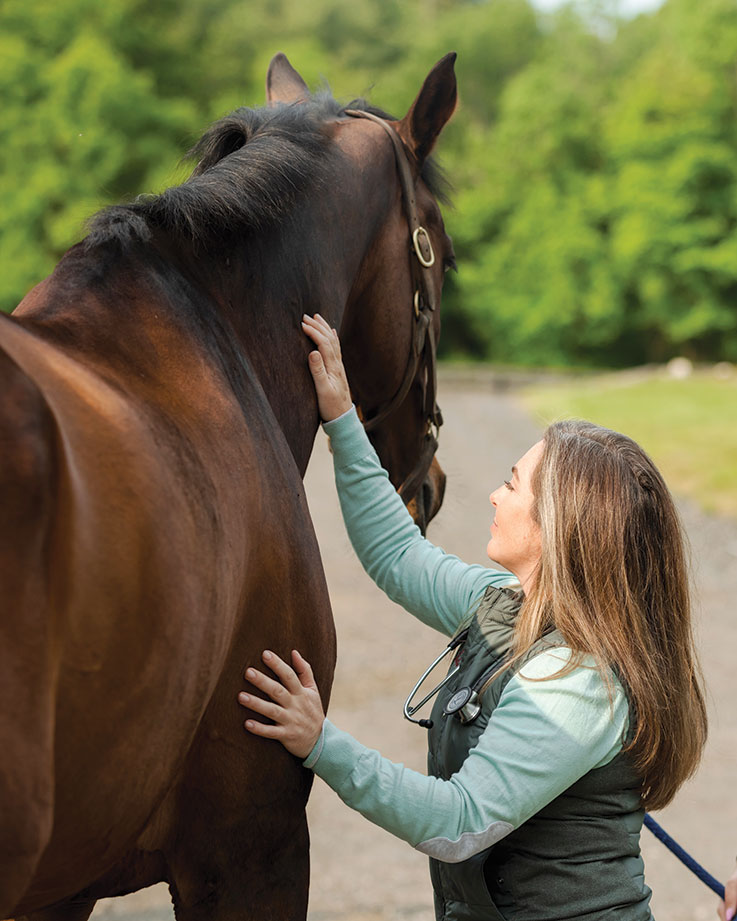
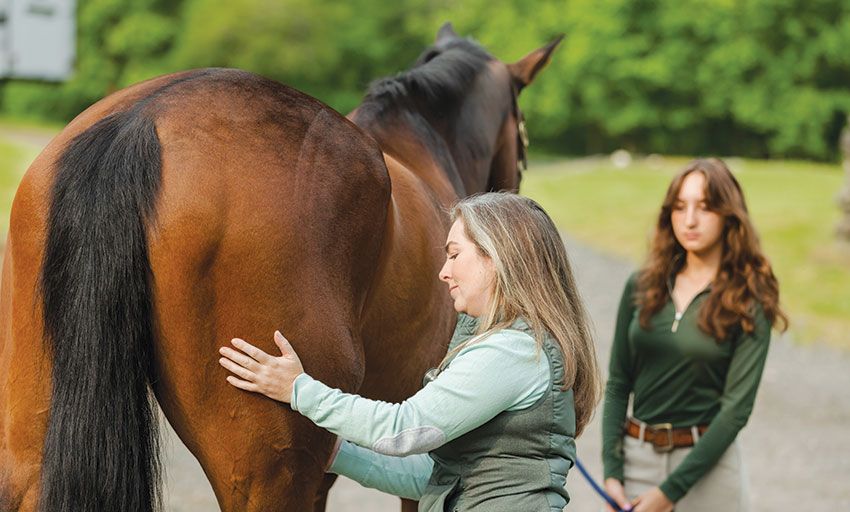
“If you look to a global definition — whether it’s equine or human, and regardless of the breed or discipline — the core provides the platform from which to execute voluntary movements of the axial (head, neck, back and chest) and appendicular (shoulders, pelvis and limbs) skeleton,” explains Dr. Melissa King.
Tools to Assess the Core
While we know that a properly fit equine core is vital to performance, stability and injury prevention, equine medicine is limited in its ability to review core muscles beyond the multifidus. Why? “Simply put, these muscles are difficult to get to, even from an imaging or muscle activation perspective,” says Dr. King matter- of-factly. There’s a complex interplay in the region, and equine veterinarians rely heavily on input and observations from the horse’s care team — the owner, rider, trainer, groom, etc. “I want to know what the horse’s riding program looks like, how often they’re worked and for how long, as well as in what sequence, are we working our horses at a level to meet the demands of performance day” says Dr. King of information she needs for her assessment. “With all of the available technology, we have riders who are able to collect athletic load data: ‘Here’s my GPS, how many miles I rode, our speed, the horse’s heart rate and how the heart rate changed when we reached maximum exercise and recovery.’ ” There’s wearable technology from the human realm that could be adapted for our equine athletes, allowing for the close and data-driven examination of athletic load and performance. “We can utilize these tools to monitor how these athletes are doing day-to-day performance-wise and also how they’re recovering,” says Dr. King of the promise this technology can provide.
While the progression of technology certainly offers valuable capabilities to better assess the equine core, a veterinarian’s physical examination, including both functional and dynamic assessments using their eyes and hands, will always carry significant weight and deliver irreplaceable conclusions. “We ask the horse to do certain functional tasks where we’re looking to observe how the muscles fire, the quality of the muscle and the range of motion through different regions,” outlines Dr. King. From palpation and flexion to observing the horse under saddle, it all comes together to create a whole-horse picture. “More and more we’re doing exams under saddle or under load, where we ask the horse to do sport-specific activities while we observe the quality of those activities. This puts the big picture together,” affirms Dr. King.
“You’re working not only on dynamic conditioning under saddle but also on the static core strengthening exercises when you’re not under saddle. ... We know from human sports medicine that, for instance, if there were four weeks of disuse and atrophy, it’s going to take double that amount of time to regain that strength, power and stability — possibly eight to 12 weeks to regain what the horse lost in four weeks.”
— Melissa King, DVM, PhD, DACVSMR, Colorado State University
Hard Earned and Easily Lost
When an injury occurs, practitioners bring immense value with the ability to not only treat it but to devise an appropriate rehabilitation plan that includes a thoughtful road map to bring the horse back to proper condition and core fitness. The goal, of course, is to avoid reinjury and set up horse and rider for long-term health, soundness and success in the show ring. “How do we target that muscle weakness component as we bring them back to full athletic performance?” asks Dr. King rhetorically. The short answer is that it takes time coupled with the dedication of the owner, rider and rehab team, especially after a recovery layoff. “You’re working not only on dynamic conditioning under saddle but also on the static core strengthening exercises when you’re not under saddle,” she details. “Although the exact time frame from muscle loss to muscle regaining hasn’t been pinpointed in the horse, we know from human sports medicine that, for instance, if there were four weeks of disuse and atrophy, it’s going to take double that amount of time to regain that strength, power and stability — possibly eight to 12 weeks to regain what the horse lost in four weeks.” The speed at which hard-earned muscle strength can be lost is staggering, but luckily there’s work happening — led by Dr. King and her colleagues in the field to educate veterinarians, rehabilitation programs and riders on how to properly bring a horse back into optimal core condition.
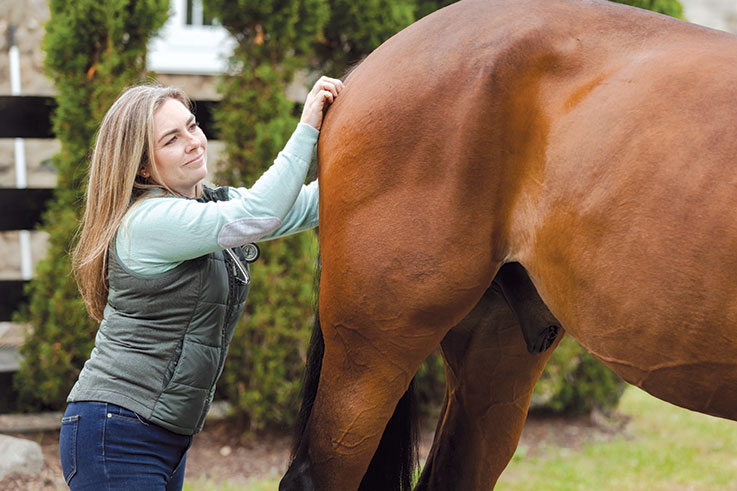
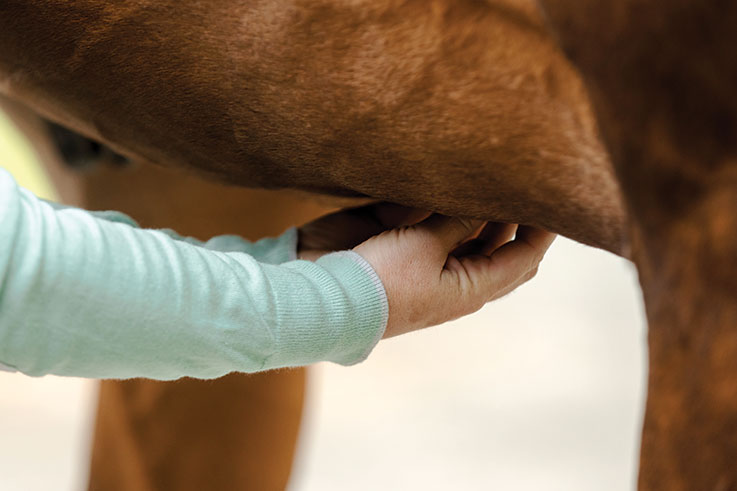
Starting Young
Like most things in life, getting ahead of a potential problem allows prevention to take center stage rather than reacting to an injury. “There’s value in a lot of the core exercise phases that are frequently used from a rehab perspective but also from a wellness and conditioning perspective. This would certainly include young horses,” says Dr. King. Picture a young and leggy warmblood, for instance. “Their legs are going everywhere, and they just don’t have the muscle-firing capacity to keep good motor control,” she adds. “I have good luck working this type of young horse in an elastic resistance band system. It allows for a proprioceptive stimulus, whether that’s around the hindquarters or under the abdomen or combined. Usually for me, the hindquarters band that I use helps make them aware that they need to engage their hind limb and pelvic stabilizers. It encourages that lumbosacral flexion and for them to have more drive and impulsion from behind.” With that small bit of additional sensory stimulus young horses are taught to better use their body and engage their musculature, with recent research suggesting that elastic band systems could also assist with increased spinal stabilization. “Additionally, things like proprioceptive balance pads can try to encourage core strength in a static position and to achieve an increase in multifidus size as well as the other postural stabilizing muscles that are responsible for keeping them in that square-stance position,” adds Dr. King. “All horses, injured or not, can benefit. Interestingly, human studies have shown that in comparison to a group of control individuals who had similar injuries but didn’t incorporate the balance and proprioceptive perturbation balanced training, the group that forewent these tools had a significantly higher reinjury rate,” she says. “In our horse population, we have been able to demonstrate that horses given proprioceptive balance pad-type training can significantly increase the size of the multifidus muscles throughout the thoracolumbar region, as well as have significant improvements in their postural control.”
Other proprioceptive devices also have been used. “Hilary Clayton (BVMS, PhD, DACVSMR, MRCVS) has done a significant amount of work applying small tactile stimulators around the fetlock and pastern area and seeing changes in range of motion within multiple joints of the fore and hindlimbs,” says Dr. King of her widely-respected colleague, who has performed innovative research in locomotor biomechanics, lameness, rehabilitation, conditioning programs for equine athletes and the interaction between rider, tack and horse. “Those changes in range of motion are associated with an increase in flexion. If you increase flexion, you have to increase the activation of the muscles responsible for flexing those joints. We increase range of motion, but we also increase muscle recruitment; it’s this sensory stimulus that changes or gives you targeted motor output.”
Increasing Balance
Melissa King, DVM, PhD, DACVSMR of Colorado State University’s College of Veterinary Medicine and Biomedical Sciences explains, “When a horse stands on a force plate, there are slight adjustments to keep their center of mass within that base of support. Those slight adjustments in their muscle tension will be measured from the force plate as changes, or displacement, in their center of pressure. If they stand stationary, their muscles are firing in order to keep them in that base of support. When they’re unstable — the wider the area they sway within and the velocity at which they displace — their center of pressure changes. I’m going to date myself here, but it would be like when we used to stand on the Wii Balance Board and follow a little red dot all over with our eyes. When horses do those balance pad exercises while they’re standing on a force plate through a rehabilitation series over roughly 12 weeks, they’ve been shown to have a significantly smaller center of pressure they swayed within. They’re much more stable, and their center of pressure velocity improved as well. Additionally, there’s a direct correlation seen as the horse becomes more balanced, the cross-sectional area of their multifidus muscle increases as well. This shows a functional connection between increasing the size of the multifidus muscle and postural control gains. These horses see major improvements in their ability to stay balanced.”
How Core Strength Affects the Back
Back pain will affect upwards of 90% of the human population at some time, with horses experiencing back pain in high numbers as well. With that said, how does the core impact equine back pain, and what can be done about that pain when it’s identified? “We know that a certain percentage of horses with lameness have back pain and vice versa,” says Dr. King. “Back pain exists or is found in anywhere from 13% to 94% of the equine population. It’s a significant issue, and there’s a lot of ongoing work trying to understand the cause and effect, and the treatment and rehabilitation.” Among the issues being researched is arthrogenic muscle inhibition, or AMI. “This happens anywhere — in humans it can be your knee, shoulder, back — but when in the presence of joint pain or inflammation, you then have altered afferent signals from that region that get relayed to the ventral horn of the spinal cord that then inhibit the alpha motor neuron output to the muscle that’s responsible for stabilizing or moving the region where the pain is coming from,” she explains. “When that pain and inflammation get resolved or treated, the muscle function does not automatically return. We therefore have to target the muscle as well; we have to build a plan where we treat the inflammation within this region and couple that with exercises that are going to work on the muscles that are responsible for stabilizing and moving that region.” This process has yet to be documented in the horse but, according to Dr. King, she sees no reason why it wouldn’t follow suit in horses as it has in humans. “If you think of it from a neurophysiologic standpoint, it makes sense that the same sort of thing is happening.”
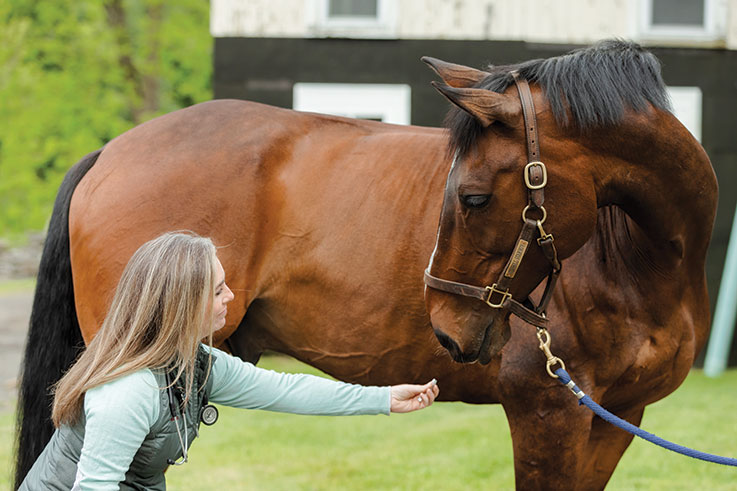
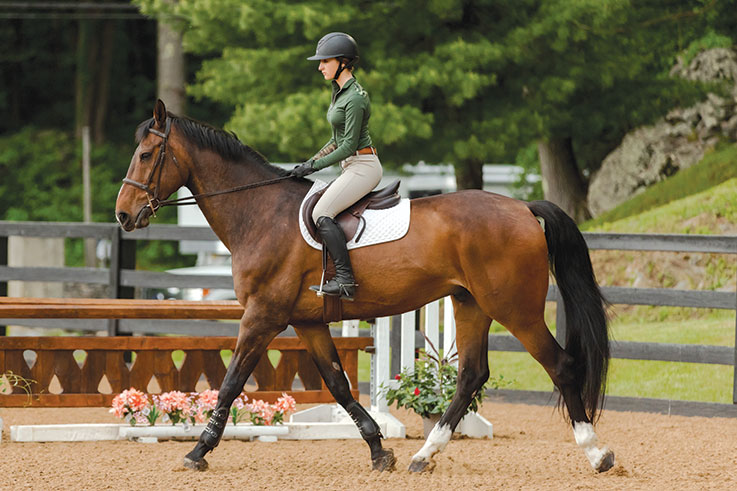
Dr. Melissa King often recommends a variety of exercises to strengthen the multifidus and other core muscles.
The Journey to An Optimal Core
Building and maintaining core musculature is one of many things in the horse world that takes a village to conquer … and to do so correctly. “This requires a close relationship between the owner or rider and their equine veterinarian, and potentially the greater team if that comes into play— maybe an equine physiotherapist, massage therapist, chiropractor, acupuncturist, farrier, whoever works on the horse’s nutrition — the whole team should be involved in building and working a program that’s functional for the horse.” There are resources available describing various techniques and types of exercises. Dr. Clayton has her own available to horse owners and veterinarians. Regardless of how owners or riders glean their information, call on the veterinarian to actively advise. “I would caution the layperson to not go out and start doing these exercises without consulting their care team,” says Dr. King. “Some of these exercises may not be appropriate for where that individual horse is at either in their stage of rehab or in the stage of their career and conditioning.” Additionally, overexercising can do more harm than good in the horse as well. “There are a lot of people who think ‘I want to do everything; tell me all the exercises, and I’ll do them every day.’ Like in people, we know that these exercises are good for horses four to five times per week but not any more than that,” cautions Dr. King pointing to a study examining the effects of performing these exercises six days per week. “The horses actually lost their flexibility gains and the improvements that they had,” she says. “More is not always better.”
Dr. King often recommends a variety of exercises to strengthen the multifidus and other core muscles. These include cervical dynamic mobilization exercises, which have been demonstrated to improve the multifidus muscle size through the thoracolumbar region. “An example would be chin to chest, chin to carpi (knee), chin to fetlock, and then lateral bending exercises like chin to stifle or hock. We also use sternal lifts where there’s a reflex response to stimulation right underneath the girth. You’re getting the rectus abdominus to contract as the horse lifts up through their back.” Lateral tail pulls, caudal tail pulls and other exercises that induce isometric contractions are useful as well. Isometric contractions are one of the first muscle activations recruited in early rehabilitation — you’re asking the muscle to produce tension without actually moving,” adds Dr. King.
Exercises such as these provide an excellent baseline for early muscle rehabilitation and muscle recovery. From there, veterinarians can recommend a variety of further exercises to appropriately follow the horse through its core muscle building or rehabilitation program. There are various forms of proprioceptive balance pads and elastic resistance band systems used to recruit abdominal muscles, lumbosacral flexion and hind limb musculature responses. Dr. King is quick to again mention the importance of relying on your veterinarian and care team when designing and executing a program. “The professionals are there for an important reason, and they bring a lot to the table,” she emphasizes. That team often includes a dedicated sports medicine and rehabilitation practitioner for specialized expertise. The primary care veterinarian and specialists work together to design elevated programs and, ultimately, aim to achieve the best results. “We can’t do it all anymore, as much as we’d like to, we’re not James Herriot,” Dr. King says with a laugh of the pen name of British veterinary surgeon and author James Alfred Wight. “To the owner and the trainer, the advantage is an amazing team that’s there to keep their equine athlete functioning at their highest capacity. We’re there to put the horse first.”
“Athletes have to be able to respond to a multitude of destabilizing forces during their activity. If they can’t respond appropriately to those situations of disequilibrium, that’s when injuries happen. The ability to have that core activated in preparation for those destabilizing forces is essential ... .”
— Melissa King, DVM, PhD, DACVSMR, Colorado State University
Core Science
Equine veterinary medicine has placed tremendously greater value on the role of proper core fitness and conditioning, and how that relates to injury prevention, stabilization, power and propulsion. Without a properly-conditioned core, the horse will not reach its athletic potential while simultaneously setting itself up for lamenesses that include its limbs and back. “Athletes have to be able to respond to a multitude of destabilizing forces during their activity. If they can’t respond appropriately to those situations of disequilibrium, that’s when injuries happen,” says Dr. King. “The ability to have that core activated in preparation for those destabilizing forces is essential, otherwise that athlete subjects themselves to the risk of an injury.” With a heightened understanding and appreciation for equine core musculature, as well as studied techniques to improve core strength and stability, equine athletes are primed for a significant leap forward in their performance, health and longevity — and for that, we have to thank those dedicated souls like Dr. Melissa King and her equine veterinary colleagues.
